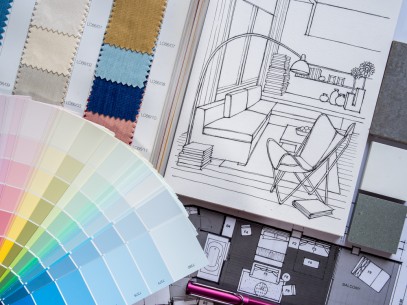By Stephanie Hyland, Storage.com
Plenty of businesses run into the same problems of running out of space to operate. Storage.com is here to help provide solutions for growing businesses, whether through unique tips or additional space.
Finding the perfect chair or pattern that makes a client smile from ear to ear is what every interior designer wants as a final result. But after the fabric has been selected and the last piece of furniture has been ordered, how can an interior designer keep their client happy and their personal space free of clutter?
Since many interior designers, especially ones who are new to the industry, are based out of their homes or small office spaces, clutter caused by client orders is something that can add up rather quickly and become a major distraction not only for the interior designer, but for current or potential clients.
By reserving a self storage unit for client orders, interior designers can use their home or office space to construct a showroom or an organized meeting space for clients instead of having to use their personal space for furniture orders that could sit there for weeks before the final installation due date.
Not to mention, most self storage facilities can cater to business storage tenants and their needs, whether that’s accepting deliveries or providing multiple units side by side.
Mia Frandsen, CCO of Mia Malcolm Inc. and host of “UpCycled” on The Design Network, says renting a storage unit is something she’s done to help prepare for installations. “Planning a design project is all about a smooth install,” she says. “Using a storage unit is really smart for designers that are still doing a lot on their own and not wanting to store every client order in their living room.”
 Frandsen says she keeps two storage units, one for accessories, the other for furniture. “We have two [20×20 units] side by side. I’ve also used my clients’s units. This allows [us to] sign off on deliveries for them. The savvy client is thrilled to do this and save on receiver fees. They also love knowing they’re in control of their purchased items.”
Frandsen says she keeps two storage units, one for accessories, the other for furniture. “We have two [20×20 units] side by side. I’ve also used my clients’s units. This allows [us to] sign off on deliveries for them. The savvy client is thrilled to do this and save on receiver fees. They also love knowing they’re in control of their purchased items.”
What’s great about storing furniture and other items for clients at a storage facility that takes deliveries is that it makes the final install easier for the designer. A commercial address allows an interior designer to schedule deliveries to the unit, and it also means the different pieces of the order have a safe place to be stored until the designer is ready for the final install.
“With the commercial address, you can easily hire a local delivery company for the final install, a service the client is pleased to pay,” says Frandsen.
Hammad Assan, manager of Jiffy Self Storage in Toronto, Canada, has seen interior designers rent units at his facility before, and he believes the fact that the facility allows deliveries has something to do with it. “We can hold single packages for a customer for a per package fee, or in the case of larger or more numerous deliveries, we can rent a unit to the customer and deposit their goods into the unit on their behalf. If the item is too large for us to move it, we can arrange for a moving company to make the move for the customer.”
Assan says that once a package has been delivered to the storage facility, the storage unit owner is notified about the recent delivery. “We notify the customer with a text message, a phone call, or an email, whatever is the preference set by the customer when their account was set up.”
Besides the ability to accept deliveries, Frandsen suggests that designers look for storage facilities with access hours that fit their schedules. For example, some designers may be okay with standard business hours (9 a.m. to 5 p.m.), but others may need extended access hours or even 24-hour access.


By reserving a storage unit at a facility with 24-hour access and gated entry, interior designers can keep track of all inventory movement, which can be especially useful with larger projects. Also, a storage unit with drive-up capabilities makes loading a truck for the final installation smoother and means couches, tables, and other items are less likely to be damaged between the unit and the client’s home.
Designers should think about climate-controlled storage when looking for storage as well. Units with climate control are kept between 55-85°F year-round and regulate humidity, which means interior designers can keep their client’s order safe from temperature-related damage, as well as mold and mildew, which can damage fabrics, wooden items, and more. Another positive aspect of climate control is that most units with this feature are indoors, so the contents inside are also protected from dust, dirt, and unwanted pests.
By renting a storage unit, designers are able to provide a safe location for their clients’s items without renting an expensive warehouse space or cluttering their home or office.
“[A storage unit] is less than office space and provides a safe place for the treasures you’ve found for your clients,” Frandsen adds. “Rather than paying $60 receiving fees per item at a warehouse, it allows a more personal approach and savings for the designer.”
Watch the Video:





